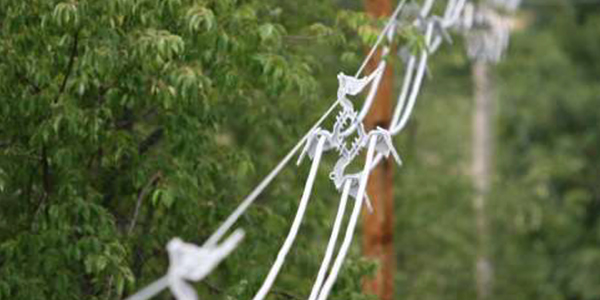By Hudson Sangree
The California Public Utilities Commission on Thursday approved Southern California Edison’s ambitious plan to install nearly 600 miles of covered conductor to prevent its higher-voltage distribution lines from starting wildfires.
The move comes after devastating utility-sparked fires swept Northern and Southern California in 2017 and 2018, causing the state and utilities to rethink prevention efforts. (See California Regulators OK Utility Wildfire Plans.)
Covered conductor, with layers of insulation to protect it from sparking vegetation, is one of the main tools that utilities plan to use in fire-prone areas.
SCE’s Wildfire Covered Conductor Program would replace bare wires with insulated ones across a sizable slice of its service territory.
This “is the first large-scale deployment of covered conductor in California to harden the distribution system against extreme weather events and designed to reduce wildfire ignition events,” Administrative Law Judge Robert Haga wrote in a proposed decision that the commission adopted unanimously, without discussion, as one of the items on its consent agenda.
In its ruling, the commission accepted a settlement between its Public Advocate’s Office, consumer groups and SCE, granting the utility more than $407 million for its Grid Safety and Resiliency Program, including nearly $285 million to install 592 circuit miles of covered conductor — representing about 6% of SCE’s primary distribution lines (typically rated at 12 to 16 kV) in high-risk fire areas.
SCE estimated a cost of $428,000 per circuit mile, including replacing wooden poles with stronger composite ones and installing fiberglass crossarms as needed.
High-voltage transmission lines have been blamed for sparking some of the worst fires in recent years, including the 2018 Camp Fire, the state’s deadliest and most-destructive blaze. A Pacific Gas and Electric line fell from a broken C-hook, igniting dry vegetation, state fire investigators found.
Distribution lines have been less prone to starting major fires. But SCE said that from 2015 to 2017, its distribution lines in high-risk regions sparked at least 132 fires large enough to report to the CPUC. The utility said 22 of the fires were started by lines contacting vegetation, more than any other identifiable cause.
“All else [being] equal, there was a relatively greater likelihood that a vegetation-related fault was ultimately associated with a fire event,” SCE said in written testimony to the CPUC in September 2018 that urged it to approve rate increases to fund its fire-prevention efforts, including covered conductor.
Covered Conductor Improves
SCE said the covered conductor now used is a big improvement over traditional tree wire that had one layer of low-density polyethylene insulation. Today’s wire, the new standard, has three layers: an outer coating of high-density polyethylene, an inner wrapping of cross-link polyethylene, and a semi-conducting sleeve wrapped around aluminum or copper wires.
The old covered conductor was heavy, required careful handling to avoid damage, and reduced load capacity because it heated up without the cooling properties of bare wire. It also was subject to degradation from the sun’s ultraviolet rays, SCE said.
The new insulated conductor is lighter but still weighs more than bare wire. It catches the wind because of its added bulk and needs stronger poles and cross arms. It also takes longer to install, said Brian Wilbur, electrical service manager with the Los Angeles Department of Water and Power.
Wilbur made his case in a separate meeting Wednesday of the CPUC’s Wildfire Safety Advisory Board, a group created last year to advise the commission’s new Wildfire Safety Division. (See California’s New Wildfire Board Holds First Meeting.)
Wilbur said LADWP is using covered conductor in high fire-risk areas.
“Covered conductors or tree wire is certainly nothing new to the industry,” Wilbur said. “But the advancement of the technology used today has made tree wire a viable solution in a lot of areas. The old tree wire that we used — that we’ve had in the systems for a long time — was heavy, required more robust construction techniques, had reduced loading capabilities and was very difficult to work with. Today’s tree wire is essentially a stronger construction material, and a lighter installation available on these conductors is becoming a great solution where other mitigating measures are not possible.”
Covered conductor is being used with along with vegetation management, composite poles, fiberglass crossarms and other measures, he told the board. The conductor adds an additional layer of safety, he said.
“One of the major things that we learned from the past wildfires is that even the most thorough vegetation management plan may not prevent branches from being blown into lines from an untrimmed palm tree on private property 50 feet away from our lines,” Wilbur said. “They can still dislodge, blow long distances and wreak havoc on our system.
“Covered conductors and resilient construction materials are critical in the high-fire-threat area to help prevent these hazards,” he said.




